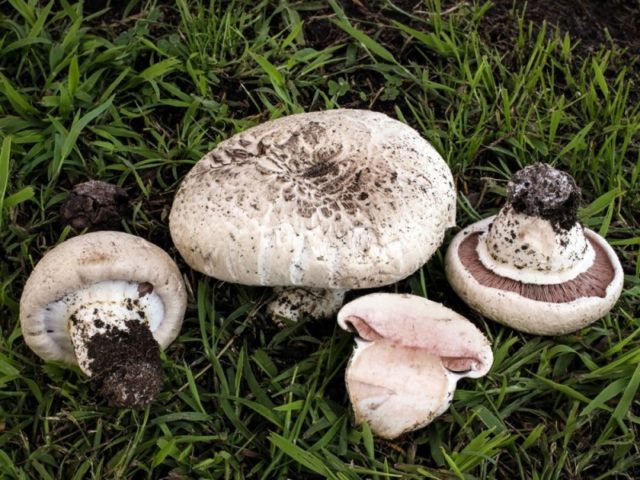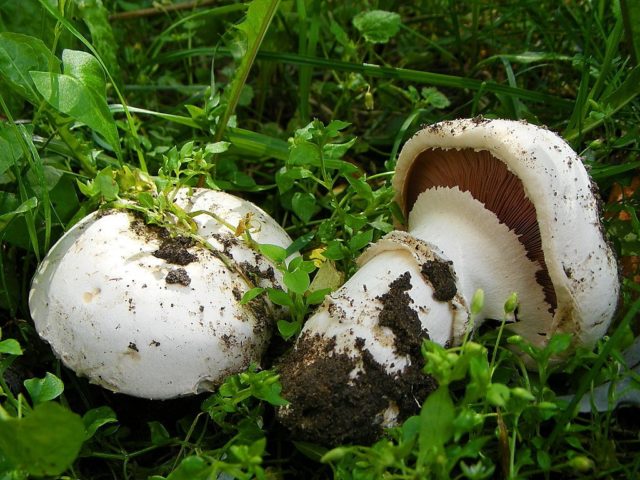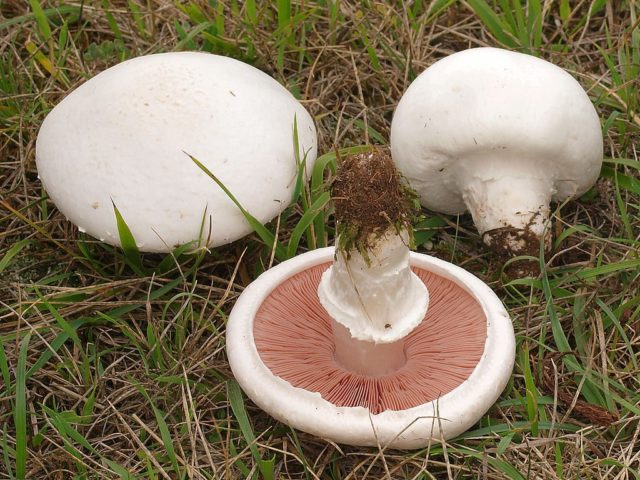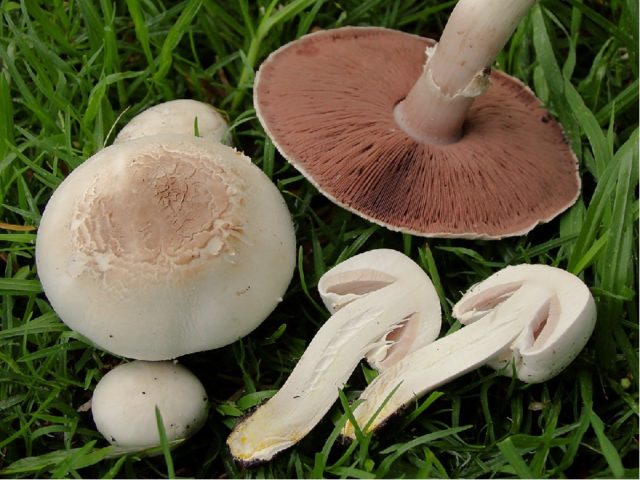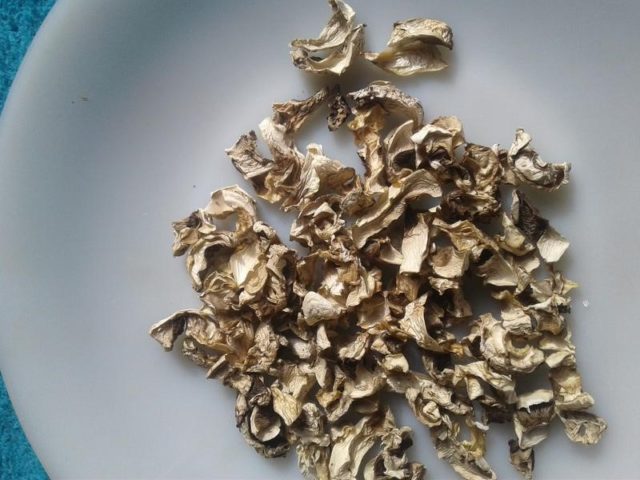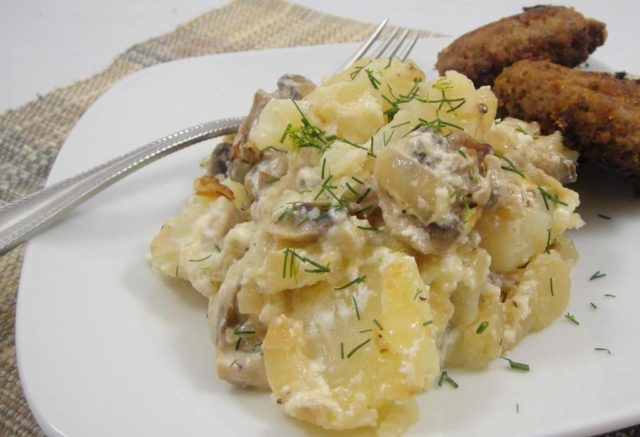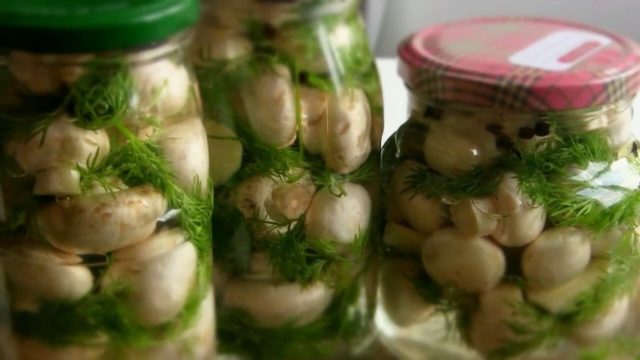Content
Bernard's champignon (Agaricus Bernardii), its other name is steppe champignon. A lamellar mushroom belonging to the extensive Agaric family and genus. Other scientific synonyms common before the thirties of the XX century:
- Psalliota Bernardii;
- Pratella Bernardii;
- Fungus Bernardii;
- Agaricus campestris subsp. Bernardii.
Bernard's champignon was first described in the eighties of the XIX century.
What Bernard's Champignon looks like
Bernard's champignon reaches very large sizes. Only the fruiting body that has appeared has the shape of a ball, with the edges of the cap strongly curled inward. Then the apex expands, taking a spherical shape with a pronounced depression in the center. Adult specimens become umbellate, with cap edges strongly curled inward and a funnel-shaped depression in the middle. The diameter of young caps is 2.5-5 cm, adult fruiting bodies reach 8-16 cm in size.
Bernard's champignon has a dry, dense cap, slightly velvety to the touch, smooth with a distinct sheen. Small chaotic cracks form a scaly pattern. The cap is creamy white, dark brown and pinkish brown spots appear with age. The color can range from milky pink to yellowish brown.
The leg is barrel-shaped, relatively short. Covered with white fluff, thickened at the root, tapering towards the cap. Dense, fleshy, without voids, pinkish at the break. Bernard's Champignon grows from 2 to 11 cm, with a thickness of 0.8 to 4.5 cm.The color is consonant with the cap or lighter.
The plates are very frequent, not accreted to the stem, at first creamy-pinkish, then darken to a coffee and brown-brown hue. The bedspread is dense, lasts a long time. In an adult fungus, it remains a filmy ring on a leg with a thinned edge. The spores are chocolate-colored, rather large.
Where Bernard's Champignon grows
Bernard's champignon is a rare mushroom with a limited habitat. Does not occur in the northern regions of Russia. Distributed in steppe zones and deserts, in Kazakhstan, Mongolia, in Europe. Bernard's champignon can often be found on the seashores of North America, in Denver. Loves saline soils: coastal sea areas, along roads sprinkled with chemicals during the winter, on salt marshes with a hard crust. It mainly lives in dense grass, sheltering from the sun so that only the tops of the caps are visible. It can be found on lawns, gardens or parks, forming characteristic "witch circles".
The mycelium bears fruit abundantly, in large groups with separately located specimens, from mid-June to late October.
Is it possible to eat Bernard's champignon
The pulp of the mushroom is white, dense, fleshy with a rather unpleasant odor. Has a pinkish tinge at break and when squeezed.Bernard's champignon belongs to the conditionally edible fruiting bodies of the IV category. Its nutritional value is rather low, the taste is not saturated with mushroom.
False doubles
Bernard's champignon is similar to some varieties of its own genus Agaric.
- Champignon Two-ring... Edible, grows in saline soils and grass, meadows and fields. It has a sour smell, an even cap without cracks, a double ring of the remains of the bedspread on the leg.
- Common champignon... Edible, it differs only in pure white flesh at the break and an even cap with pronounced rare scales. Rich mushroom smell.
- Champignon Yellow-skinned (redhead or chives). Very poisonous. Bernard's champignon from him is almost indistinguishable in appearance. Has bright yellow blotches on the cap and stem. When cut, the pulp becomes yellowish and gives off an unpleasant phenolic odor.
- Amanita Smelly (White) - deadly poisonous. It differs from Bernard's Champignon in an even, bright white, slightly creamy color along the entire stem and cap, a slightly sticky surface after rain. Has an unpleasant smell of rotting potatoes.
- Pale toadstool (fly agaric green) - deadly poisonous. It is distinguished by a brownish-olive color of the cap and a noticeable thickening at the root of the stem. Young fruit bodies are difficult to distinguish by smell, they have a pleasant mushroom smell, but the old ones have a rich rotten aroma.
Collection rules and use
Bernard's champignon is recommended to be picked when young, when the edges of the cap are still distinctly curled down, and the plates are covered with foil. It is best to grab the edges and, pressing lightly, twist them out of the mycelium. Do not take overgrown, dried out, spoiled specimens.
Bernard's champignon can be used fried, boiled, frozen, and also salted and pickled. Fruit bodies should be cleaned and rinsed well before cooking. Do not soak them for more than 30 minutes in salted water, otherwise the product will become watery. Clean hats and legs from dirt and films. Cut large specimens into pieces. Pour water into a saucepan, add salt at the rate of 1 tsp. per liter, boil and add mushrooms. Cook for only 7-8 minutes, skimming off the foam. The product is ready for further processing.
Drying
Bernard's champignon has a surprisingly mild taste when dried. For this, the fruit bodies must be cleaned of films and debris. Do not wash or wet. Cut into thin slices and hang on threads. It can also be dried in an electric dryer or in a Russian oven. The dried product can be ground in a mixer or meat grinder to obtain nutritious mushroom powder.
Fried Bernard's champignon with potatoes and sour cream
A simple, hearty dish loved by generations of avid mushroom pickers.
Required products:
- boiled champignon Bernard - 1 kg;
- potatoes - 1 kg;
- turnip onions - 120 g;
- sour cream - 100 ml;
- vegetable oil - 30-50 ml;
- salt, pepper, herbs to taste.
Cooking method:
- Rinse vegetables, peel, cut into strips. Put the onion in a hot skillet with oil and fry.
- Add potatoes, salt and pepper, put boiled mushrooms, fry over medium heat for 10-15 minutes.
- Add sour cream mixed with chopped herbs and simmer covered for 10 minutes.
The finished dish can be eaten like this or served with fresh salad, cutlets, chops.
Bernard's mushroom stuffed
For stuffing, large, even specimens are needed.
Required products:
- boiled champignon Bernard - 18 pcs.;
- boiled chicken fillet - 190 g;
- hard cheese - 160 g;
- turnip onions - 100 g;
- sour cream - 30-40 ml;
- vegetable oil - 30-40 ml;
- salt, pepper, herbs to taste.
Cooking method:
- Peel the onion, rinse, cut into cubes or strips. Fry in oil until transparent.
- Cut the legs of the mushrooms, chop finely, add salt, pepper, add to the onion and fry for 5-8 minutes.
- Grind the fillet in any convenient way, coarsely grate the cheese.
- Mix the meat with the roast, add herbs, sour cream. Taste, add salt if necessary.
- Rub the hats with salt, put on a baking sheet, stuff with minced meat with a heap, sprinkle with cheese.
- Preheat the oven to 180 degrees, place the food and bake for 20-30 minutes.
A deliciously delicious dish is ready.
Bernard's mushroom pickled
One of the most popular ways of harvesting for the winter.
Required products:
- boiled champignon Bernard - 2.5 kg;
- water - 2.5 l;
- vinegar 9% - 65 ml;
- dill stalks with umbrellas - 90 g;
- horseradish, currant, oak leaves (available) - 10 pcs.;
- garlic - 10 cloves;
- bay leaf - 9 pcs.;
- peppercorns - 20 pcs.;
- sugar - 40 g;
- salt - 50 g.
Cooking method:
- In an enamel bowl, mix water and all dry foods, boil the marinade.
- Add the chopped mushrooms and cook for 10-15 minutes, stirring to remove the foam.
- 5 minutes until ready to pour in the vinegar.
- Put garlic, dill, green leaves in a prepared container.
- Put boiling mushrooms, touching tightly, pour marinade, seal tightly.
- Turn upside down, wrap in a warm blanket for a day.
Conclusion
Bernard's champignon is an edible lamellar mushroom that prefers saline soils and grassy steppes. When collecting or buying it, you should show maximum attention, since it has deadly poisonous counterparts. From this fruiting body, delicious dishes are obtained. Bernard's champignon can be used both immediately after harvest and in preparations for the winter. Boiled frozen mushrooms remarkably retain their natural taste and aroma; they can be used to prepare first and second courses, salads.
